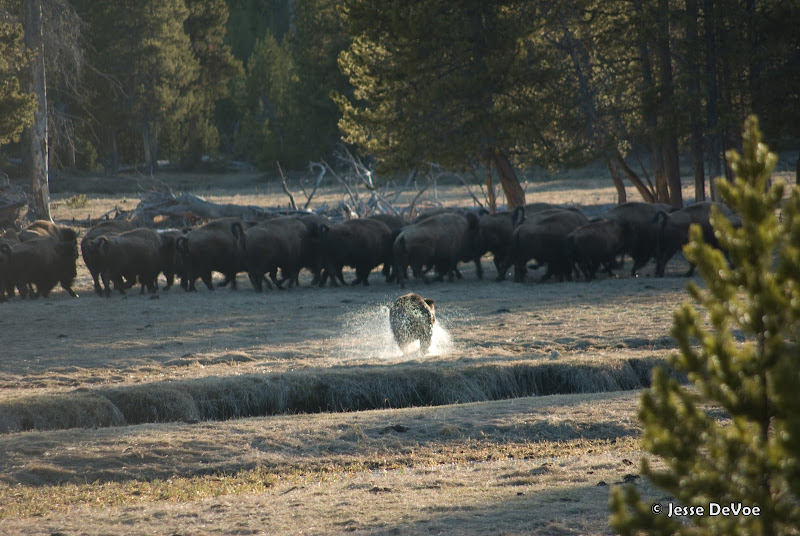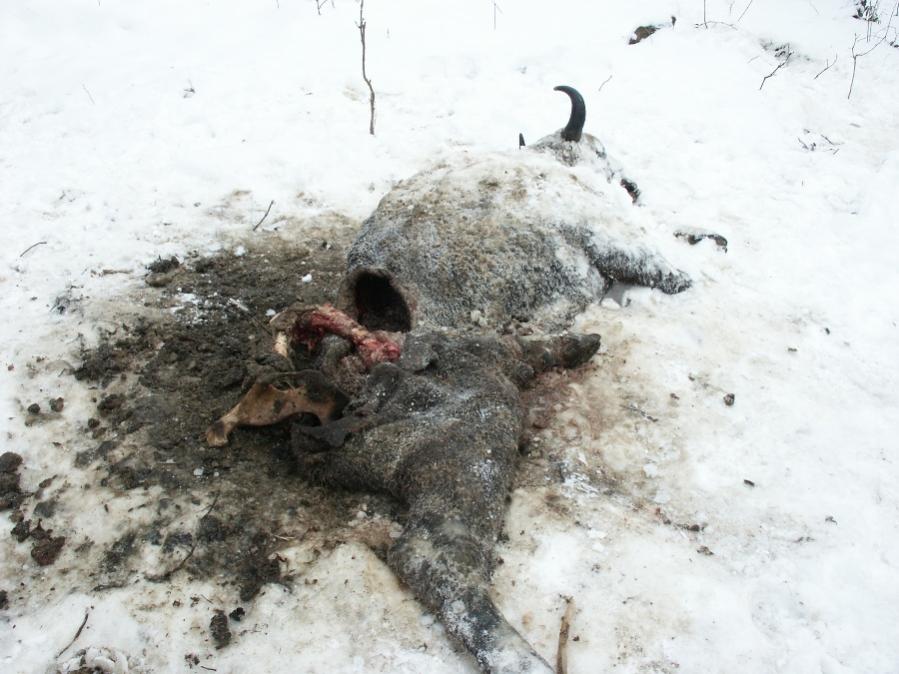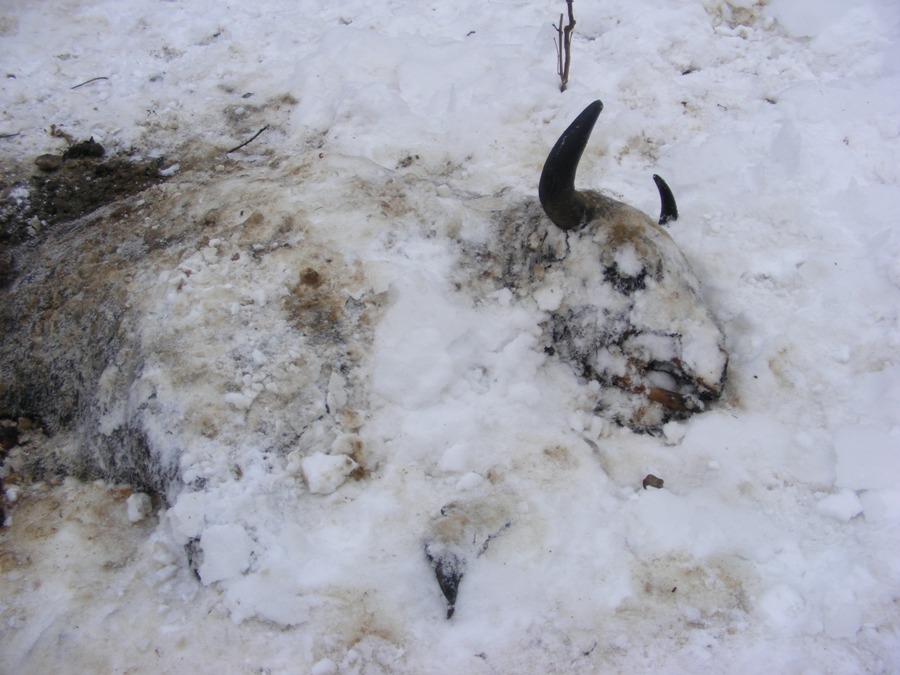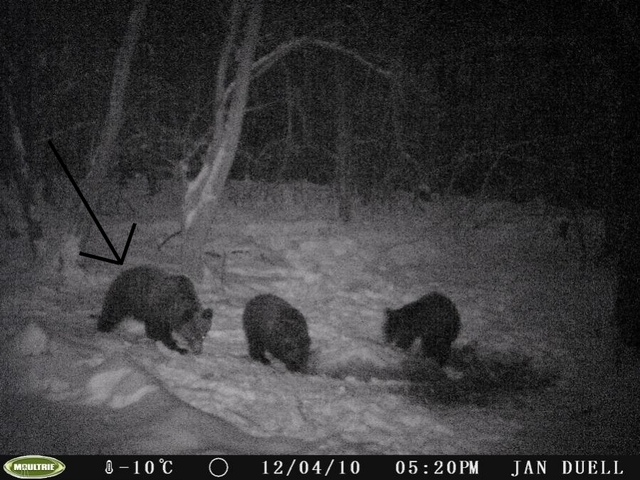Deleted
Deleted Member
Posts: 0
|
Post by Deleted on Sept 11, 2011 1:29:26 GMT -9
How large is that bear?
|
|
|
|
Post by grrraaahhh on Sept 14, 2011 7:37:09 GMT -9
If you mean the 'Preacher', I do not know the exact weight but I would guess somewhere between 700-900 lbs range. |
|
|
|
Post by Agriotherium on Nov 10, 2011 13:11:41 GMT -9
I have read about that, but I have not any documentary about it. Does brown bear hunt on adult bisons or not?
|
|
|
|
Post by grrraaahhh on Nov 10, 2011 16:52:38 GMT -9
I moved your question to the 'Bison' section where there is relating information. Predation of adult bison by grizzly/brown bear is rare but such events do occur.
|
|
|
|
Post by Agriotherium on Nov 11, 2011 2:35:50 GMT -9
And why it is rare?
|
|
|
|
Post by grrraaahhh on Nov 11, 2011 14:07:41 GMT -9
Consider the following: - Adult bison are formidable prey weighing between 300-1000 kg.
- The historic range and population for bison and brown bear in both Europe and North America have been radically reduced.
- The brown bear's diet is overwhelmingly (90%) plant based. What meat input there is comes via scavenging, fish, and a smaller % from hunting.
- The brown bear is not designed for effective hunting. IMO, they are more opportunistic hunters especially as it relates to adult prey (regardless of animal) which are harder to catch and kill. Beyond left over dead carcass or carrion scavenging, it is simpler for the bear to extract bison victim from wolves or fresh meat kill from other carnivores.
- The majority of ungulate kill by brown bear are young/neonate prey - in other words the easiest and most vulnerable. Of the adult ungulate victims, the perpetrator profile is more often an adult male bear. True to form, as it relates to adult bison, the male bear perpetrator (likely an alpha or prime boar type) is probably a specialized and opportunistic adult bison killer who has perfected his art. Perhaps when there were more bison and brown bear both in Europe and North America there were more of these specialized bison killers especially of the woodland bison (not plain bison) in both continents.
|
|
|
|
Post by grrraaahhh on Dec 9, 2011 11:09:52 GMT -9
In Gary Brown's book Great Bear Almanac he relates three stories of grizzly bear attacks on Bison. It's tough to say but it appears the first two stories might be the same event where a grizzly bear is killed in a fierce battle with a buffalo suffering punctured holes, broken ribs, as the surrounding area was heavily torn up evidence of a fierce battle. Brown provides references and if I obtain more information I will make a follow up post.
The last event described by Brown (as told by a Dakota hunter) involves a large grizzly bear attacking a herd of bison cows who were protected by 5-6 bison bulls. As the bear approached the herd the bulls closed ranked and attacked the bear. The bear paw swiped attacked one of the charging bulls, the blow was so hard that it broke the bull's back killing it instantly. The remaining bulls were able to drive away the bear inflicting mortal wounds.
|
|
Deleted
Deleted Member
Posts: 0
|
Post by Deleted on Dec 9, 2011 17:38:47 GMT -9
There are many accounts that say a grizzlies paw swipe is powerful enough to even kill a bison.
Probably back those days when the bisons were more plentiful, there were more bsion hunting specialise among the grizzlies.
I am not doubting the strength of the grizly, however, that one blow could be a well-placed one. Impressive nevertheless.
|
|
|
|
Post by sarus on Jun 25, 2012 18:25:31 GMT -9
Preacher the Bison Killer in Action! Preacher preparing his sermon... (there is a river between him and the bison in this shot)   A last, desperate self-baptism by the Preacher bear ==================================================== ==================================================== For more photos and the whole story, visit the following blog:www.aspiringecologist.comwww.aspiringecologist.com/2010/04/very-beary.html==================================================== ====================================================
|
|
|
|
Post by grrraaahhh on Jul 10, 2012 20:10:02 GMT -9
Preacher the Bison Killer in Action! Preacher preparing his sermon... (there is a river between him and the bison in this shot)   A last, desperate self-baptism by the Preacher bear ==================================================== ==================================================== For more photos and the whole story, visit the following blog:www.aspiringecologist.comwww.aspiringecologist.com/2010/04/very-beary.html==================================================== ==================================================== Thanks! |
|
|
|
Post by grrraaahhh on Aug 12, 2012 4:25:32 GMT -9
|
|
|
|
Post by grrraaahhh on Aug 13, 2012 9:18:35 GMT -9
FWIW, I think we are ahead of the curve as it relates to the "Preacher". My guess, we will see some kind of report or peer reviewed paper released dealing with this specific bear. |
|
|
|
Post by grrraaahhh on Aug 13, 2012 9:32:53 GMT -9
Adequate funding is another factor to consider for grizzly bear/bison relation analysis: Above: North American bison range.  Alaska Bison Alaska Bison“Wolves, black bears, and brown bears are relatively abundant in the Copper River bison range. These predators are certainly capable of killing bison, but we have not conducted research into predation rates on Copper River bison.” “Wolves, black bears and grizzly bears are all numerous on the home range of the Copper River herd but their impacts have not been researched.” “Predation. Trappers and local residents have reported wolf predation on bison. Brown bears have also been observed feeding on bison carcasses, but it is not known if they killed the bison or were scavenging. Research on wolf or brown bear predation on bison has not been conducted because of high costs associated with such study and because of remote nature of the herd.” “The Chitina bison herd declined by almost 50% between 1985 and 1989, remained relatively stable through 1995, increased for 2 years, then experienced a severe die-off during the winter of 1997–98. The herd has increased slowly since. Small fluctuations in count data between years probably reflect survey technique rather than actual changes in bison numbers. Solitary bulls are especially difficult to find on aerial surveys. Legal harvests by sport hunting were stopped in 1989 after the herd declined. Because the herd continued to grow in prior years, even with a sport harvest, hunting was not considered a limiting factor on herd growth. Severe winters with deep snow and lack of sufficient wind to clear bars of snow are now considered important limiting factors on bison productivity and survival. Flooding of critical river bars and loss of vegetation cover has reduced carrying capacity, especially during periods of deep snow. Wolves and brown and black bears are abundant and could also influence herd size, but a lack of research precludes documenting predation rates." Natural Mortality“We did not find evidence that wolves and grizzly bears killed bison calves or adults. However, the reported harvest accounts for only about two-thirds of the number of calves seen each year. Either natural mortality of calves or adults has increased substantially in recent years or the Farewell bison population is growing. Disease was also rare in the herd. We planned to search for bison carcasses in April 2002 to estimate natural mortality, but no aircraft were available.” LiteratureBison Management Report of survey-inventory activities 1 July 1999–30 June 2001 Carole Healy, Editor Alaska Department of Fish and Game Division of Wildlife Conservation December 2002. PDF LINK: www.adfg.alaska.gov/static/home/library/pdfs/wildlife/mgt_rpts/bi02mt.pdfAlso...additional ADF&G Report material (same wording, different dates):Bison Management Report of survey-inventory activities 1 July 2003–30 June 2005 Patricia Harper, Editor Alaska Department of Fish and Game Division of Wildlife Conservation December 2006. PDF LINK: www.google.com/url?sa=t&rct=j&q=bison+management+report+alaska&source=web&cd=2&ved=0CEQQFjAB&url=http%3A%2F%2Fwww.adfg.alaska.gov%2Fstatic%2Fhome%2Flibrary%2Fpdfs%2Fwildlife%2Fmgt_rpts%2F06_bison.pdf&ei=XzwpUOWUKuq-6QHmooHQDQ&usg=AFQjCNHiEjO2IO2aIs9o4z9VDxo373Mcjg&cad=rja
|
|
|
|
Post by warsaw on Dec 18, 2012 10:46:44 GMT -9
"...Predation. A few circumstances have suggested occasional predation by the grizzly bear (Ursus arctos) on bison calves and adults in Yellowstone National Park,Wyoming (McHugh 1958; Meagher 1973). In the past, predation on bison by wolves in Yellowstone has not been a problem, as evidenced by the long survival time of injured and solitary animals and by the fact that wolves were rare and never observed in packs (Meagher 1973). However, with the reintroduction of 31 Canadianwolves intoYellowstone National Park in 1995–1996, this situation is expected to change with an increasing number of wolf–bison interactions and kills made during spring (Smith et al. 2000)..." "... The importance of scavenged or killed bison in the diets of grizzly
bears is considerably reduced from what it likely was when the plains
grizzly and large bison herds coexisted on the Great Plains, although bison
are significant contributors to grizzly bear diets where these species
still coexist. A radiotelemetry study of grizzly bear in Yellowstone revealed that 95% of the energy requirements of grizzly bears were being derived from the largest bodied ungulate species; scavenged adult bison made up 16% of that total (Mattson 1997).Winter-killed bison and other ungulates may be important food sources to bears in early spring after they emerge from dens (Meagher 1978). In Yellowstone National Park, three grizzly bears captured an elk calf within 213 m of a bison herd without causing alarm to the bison (McHugh 1958). On occasion, bison prove too large an adversary for grizzly bears and may kill their would-be predators (McHugh 1972). The role of bison in black bear ecology can be expected to parallel that of grizzly bear where black bear and bison ranges overlap. During a wolf study from 1975 to 1978 in the Slave River Lowlands, Northwest Territories, observations of black bears following bison groups and feeding on bison carcasses during the calving and postcalving seasons were made, but no observations were made of black bears actually chasing, attacking, or killing bison (Van Camp 1987). Black bears are opportunistic scavengers and probably scavenge on bison carcasses when available..." www.wildlifeaccidents.ca/docs/bisonchap48%20p-1009-1060reynoldsgatesglaholt290803.pdf |
|
|
|
Post by warsaw on Dec 26, 2012 15:33:43 GMT -9
[/img]   The killer:  [/quote] Cost-effectiveness of strategies to establish a European bison metapopulation in the Carpathians www.botany.wisc.edu/waller/PDFs/Kuemmerle_etal_2011_JAE.pdfPredation of European bison by "...brown bears in the Carpathians has been rare (five reported cases since the 1960s)..." |
|